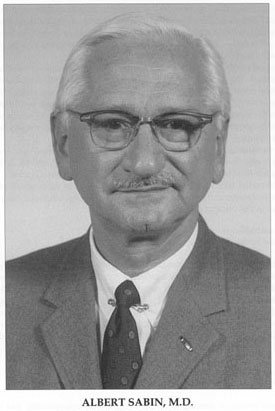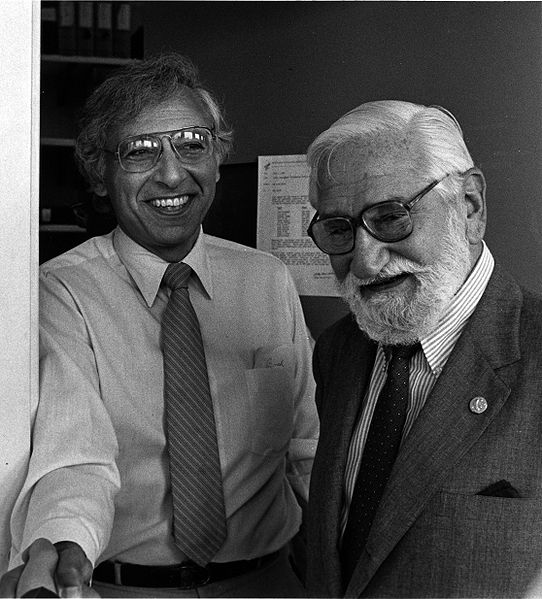<Back to Index>
- Immunologist Albert Bruce Sabin, 1906
- Writer Louis Henri Jean Farigoule (Jules Romains), 1885
- Elector Palatine Friedrich V, 1596
PAGE SPONSOR


Albert Bruce Sabin (August 26, 1906 – March 3, 1993) was an American medical researcher best known for having developed an oral polio vaccine.
Sabin was born in Białystok, Russia (now Poland), to Jewish parents, Jacob and Tillie Saperstein. In 1921 he immigrated with his family to America. In 1930 he became a naturalized citizen of the United States and changed his name to Sabin.
Sabin received a medical degree from New York University in 1931. He trained in internal medicine, pathology and surgery at Bellevue Hospital in New York City from 1931 - 1933. In 1934 he conducted research at The Lister Institute for Preventive Medicine in England, then joined the Rockefeller Institute for Medical Research (now Rockefeller University). During this time he developed an intense interest in research, especially in the area of infectious diseases. In 1939 he moved to Cincinnati Children's Hospital in Cincinnati, Ohio. During World War II he was a lieutenant colonel in the U.S. Army Medical Corps and helped develop a vaccine against Japanese encephalitis. Maintaining his association with Children's Hospital, by 1946 he had also become the head of Pediatric Research at the University of Cincinnati. At Cincinnati's Children's Hospital, Sabin supervised the fellowship of Robert M. Chanock.
In 1969 - 1972 he lived and worked in Israel as the President of Weizmann Institute of Science in Rehovot. After his return to the United States he worked (1974 – 1982) as a Research Professor at the Medical University of South Carolina. He later moved to Washington, D.C.area where he was a Resident Scholar at the John E. Fogarty International Center on NIH campus in Bethesda, MD. With the menace of polio growing, Sabin and other researchers, most notably Jonas Salk in Pittsburgh and Hilary Koprowski and Herald Cox in New York and Philadelphia, sought a vaccine to prevent or
mitigate the illness. In 1955, Salk's "killed" vaccine was released for
use. It was effective in preventing most of the complications of polio,
but did not prevent the initial, intestinal infection. In addition,
those who received the Salk vaccine could pass on the polio virus.
Sabin first tested his live attenuated oral vaccine at the Chillicothe
Ohio Reformatory in late 1954. From 1956 - 1960 he worked with Russian
colleagues to perfect the oral vaccine and prove its extraordinary
effectiveness and safety. The Sabin vaccine worked in the intestines to
block the poliovirus from entering the bloodstream. It was in the
intestines, Sabin had discovered, the poliovirus multiplied and
attacked. Thus, the oral vaccine broke the chain of transmission of the
virus and made possible the world wide eradication of polio. Between
1955 - 1960, the oral vaccine was tested on at least 100 million people
in the USSR, parts of Eastern Europe, Singapore, Mexico and the
Netherlands. The first industrial production and mass use of Oral
Poliovirus Vaccine (OPV) from Sabin strains was organized by Soviet
scientist Mikhail Chumakov.
This provided the critical impetus for allowing large scale clinical
trial of OPV in the United States in April 1960 on 180,000 Cincinnati
school children. The mass immunization techniques that Sabin pioneered
with his associates effectively eradicated polio in Cincinnati. Against
considerable opposition from The March of Dimes Foundation, which
supported the relatively effective killed vaccine, Sabin prevailed on
the Public Health Service to license his three strains of vaccine.
While the PHS stalled, the USSR sent millions of doses of the oral
vaccine to places with polio epidemics, such as Japan, and reaped the
humanitarian benefit. Indeed it was not clear to many that the vaccine
was an American one, financed by US dollars, but not available to
ordinary Americans. Sabin vehemently opposed the use of the Salk inactivated vaccine and attempted to block its use. In 1983, Sabin developed calcification of the cervical spine, which caused paralysis and intense pain. According to Keith Olbermann, Sabin revealed in a television interview that the experience had made
him decide to spend the rest of his life working on alleviating pain. This condition was successfully treated by surgery conducted at Johns Hopkins Hospital in 1992 when Sabin was 86.